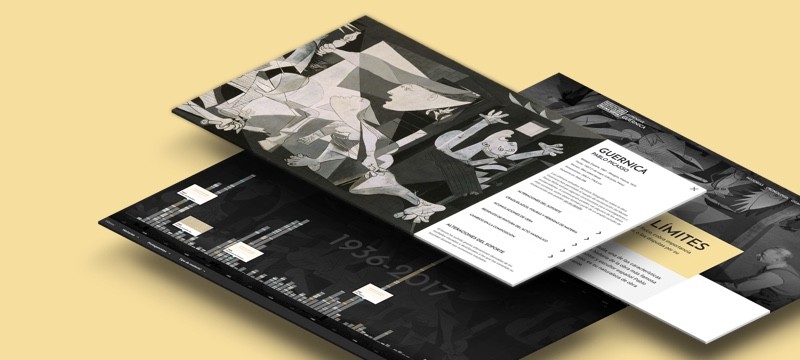Interpretation
The visual impact of Guernica from the time it was unveiled to the public in 1937 has filled the pages of texts and articles which have tackled its formal aspects, artistic references and the way in which it portrays the violence of war. Yet Juan Larrea’s allegorical interpretation in his text Guernica, published in 1947, has ignited debates over the meaning of the painting and the different figures which appear on its surface. In November of the same year, Alfred H. Barr Jr. and Monroe Wheeler organised a symposium on Guernica at the Museum of Modern Art (MoMA), New York, where this matter was the main subject of discussion.
Since it came into being, Guernica has fuelled numerous debates, readings and interpretations that have sought to fathom each symbol and inscription of the figures in the work — for instance in the early writings of Emily Genauer, Elizabeth McCausland and Anthony Blunt, among others — and to explore its artistic references and place in the history of art. The provenance of these reflections is not solely art critique; documentaries, films, and vignettes, Ad Reinhart’s for example, have put forward readings on the different aspects of the painting, turning it into a source of multiple meanings.
The 1940s was a decade which gave rise to a specific reading of Guernica, its political power by no means banal. In such a political and social climate, bearing in mind the hegemony in the USA in the aftermath of the Second World War and the suspicion towards communism with the backdrop of the Cold War, from inside the Museum of Modern Art in New York, and for the purposes of art history, there was a need to shed light on exactly what Guernica was and to grasp hold of its symbolic value. Picasso’s declarations at the end of October in 1944, two months after the liberation of Paris, in which he declared his affinities with the French Communist Party, together with the celebration of the fast-approaching tenth anniversary of Guernica’s creation, and the publication of Juan Larrea’s monograph on the artist, aroused huge interest in the work in May 1947, with Picasso urged to elucidate the work’s symbolism. Larrea’s text emerged from an epistolary exchange with Kahnweiler — on his and the artist’s behalf — and Barr, who urged Picasso to expound his opinion on the matter; yet the artist always refused to offer explanations.
At a time of huge political tension in the USA, of suspicion over anything considered anti-American, Alfred H. Barr Jr., as an art historian and former director of MoMA, and as the current director of the same museum’s Collections Department, set out to clarify the tenor of the painting. On 25 November 1947, Barr organised a symposium in the museum to explain and throw light on the picture, and to reach the formulation of one sole reading of it, thus determining the value of each element, particularly the bull and the horse, and its iconography. Without ignoring its quality as a political work of art, yet also adhering to the debates surrounding the painting — melding figuration and abstraction — which was touring the US at the time, Barr’s aim was to close off other interpretations and blur the allegorical nature of Guernica. However, the texts and publications on the piece have mushroomed ever since, demonstrating the capacity for renewed interest in both the historical questions it poses and the very nature of the work. Moreover, as the journeys of the painting attest through its civic exhibition and anonymous appropriations, its meaning as an anti-war image par excellence has lasted and transcended its mere symbology.



